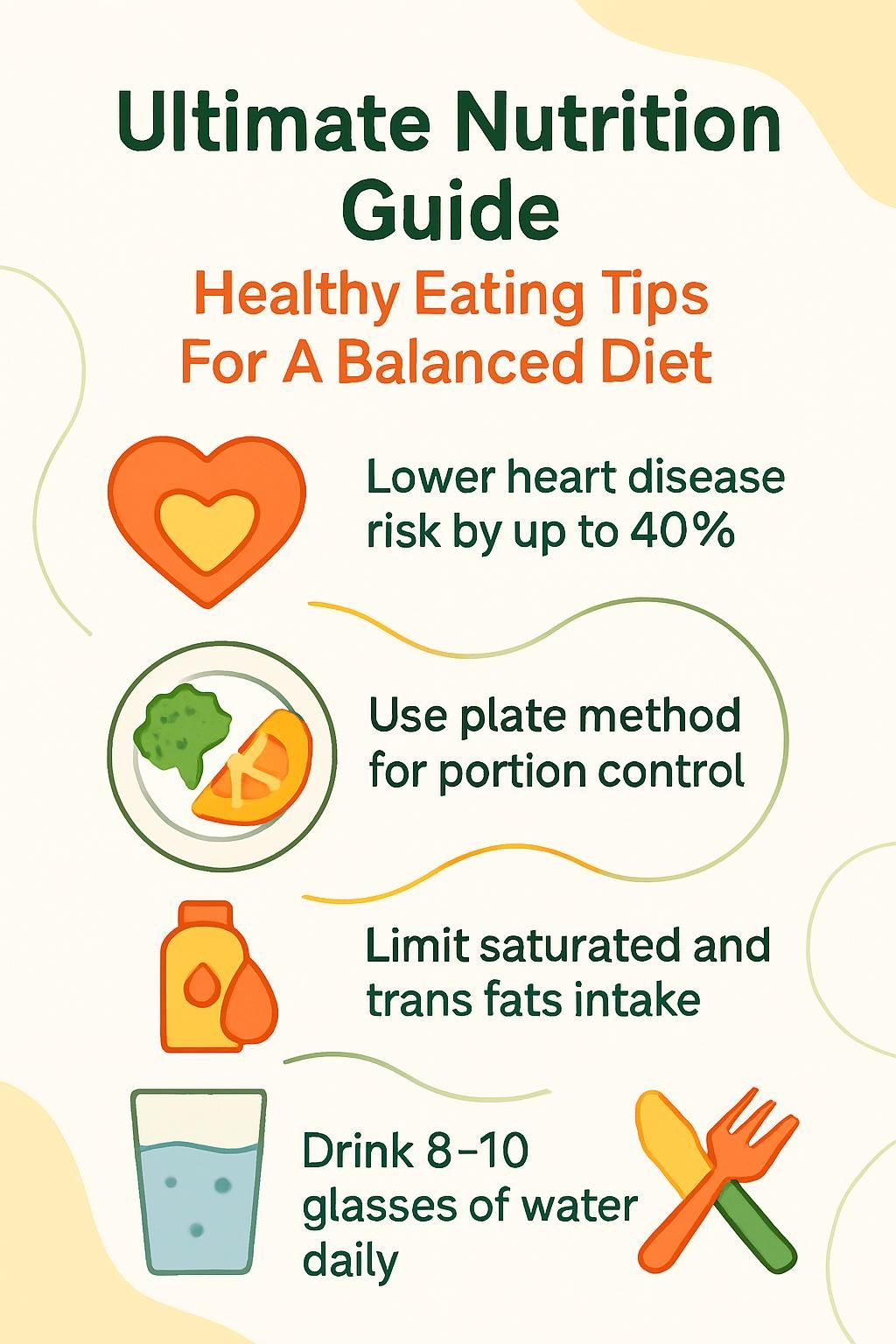Ultimate Nutrition Guide: Healthy Eating Tips For A Balanced Diet
Our Nutrition Assistant AI Suite will transform your body. You will lose fat, get toned, and build muscle. Gain confidence and optimal health.
Healthy eating can feel noisy with so many opinions online. A balanced diet gives you steady energy and helps protect your heart and weight. Focusing on fruits, vegetables, whole grains, lean proteins, and healthy fats is a simple path that works.
This Nutrition Guide breaks down the main food groups, shows easy portion tips like the plate method, and offers meal planning ideas based on USDA tools such as MyPlate. You will also get smart strategies for shopping, cooking, and dining out, so healthy choices fit real life.
Start with one change today. Small steps add up.
Key Takeaways
- Following a balanced diet with fruits, vegetables, whole grains, lean proteins, and healthy fats can lower heart disease risk by up to 40% for men and 30% for women (Dietary Guidelines for Americans 2020–2025).
- Use the plate method, half vegetables and fruits, one quarter protein, one quarter whole grains, to manage portions. Fill your plate mostly with plant foods as MyPlate suggests.
- Limit saturated and trans fats from processed meats and full-fat dairy. Choose nutrient-dense options like beans, seeds, fish rich in omega-3s, and plant oils (American Heart Association).
- Drink 8 to 10 glasses of water daily instead of sweetened drinks. Check Nutrition Facts labels to minimize added sugars and unhealthy fats.
- Use MyPlate Kitchen and Shop Simple with MyPlate to plan varied meals, cut costs, reduce waste, and track nutrients.

Why is a balanced diet important for health?

A balanced diet supplies the nutrients your body needs to work well. It lowers the risk of heart disease, stroke, high blood pressure, and some cancers, as described in the Dietary Guidelines for Americans 2020–2025.
Research shows strong benefits. Men who followed healthy eating patterns saw about a 40 percent drop in cardiovascular risk, and women saw nearly a 30 percent drop. In a long study of more than 7,300 adults, higher Alternate Healthy Eating Index scores linked to a 25 percent lower mortality rate.
Nutrient-dense foods, such as whole grains, vegetables, fruits, lean meats or fish, beans, and healthy oils, support stable energy and focus. Swap refined items for whole foods, and you may notice better concentration within weeks. Using tools like MyPlate or the DASH diet can also help you manage calories and reduce saturated fat.
Understanding macronutrients
Macronutrients are carbohydrates, proteins, and fats. They provide energy and support growth, repair, and daily function. Knowing good sources makes healthy choices easier.
What are healthy sources of carbohydrates?
Choose whole grains like brown rice, quinoa, oats, and whole wheat bread. They give steady energy and more fiber and nutrients than refined grains. Fiber helps manage blood sugar and keeps you full longer.
Fill most of your plate with vegetables and fruits. Aim for at least five servings a day. Berries, apples, leafy greens, and beans provide complex carbohydrates that digest slowly.
Vegetables such as broccoli and carrots give vitamins with few calories. Beans add both protein and slow-digesting starch to soups and salads.
Limit potatoes and skip fries, which spike blood sugar. Avoid sugary drinks like soda and juice since they add sugar without fiber.
“Choosing whole grains instead of refined grains can lower your risk of heart disease by helping control cholesterol levels.”
Which foods provide the best proteins?
Good protein options include fish, poultry, eggs, dairy, beans, lentils, tofu, and nuts. Variety matters. Rotate plant and animal sources to cover essential amino acids, the building blocks your body uses to grow and repair tissue.
Limit processed meats to reduce heart risk and sodium intake. Pick grilled chicken, baked fish, or bean-based dishes more often to keep saturated fat in check.
Plan protein in each meal. During meal prep, grilled chicken or black beans are easy choices that support muscle health without extra saturated fat.
What are the benefits of healthy fats and where to find them?
Healthy fats help lower LDL cholesterol, often called bad cholesterol, and support brain and heart health. Replace solid fats like butter with oils such as olive or canola.
Top sources include avocados, nuts, seeds, and vegetable oils. Try avocado on whole grain toast for breakfast, or snack on almonds instead of chips. These swaps add flavor and improve your fat profile.
There is no single calorie cap for healthy fats, but keep saturated and trans fats low. A simple change, like using extra virgin olive oil on salads, can improve taste and heart health over time.
Key dietary guidelines for healthy eating
Clear rules make daily choices easier. These guidelines will help you build balanced meals, limit harmful ingredients, and stay hydrated.
How can I eat a variety of nutritious foods daily?
Eating many colors and types of foods improves nutrient coverage and keeps meals interesting.
- Follow MyPlate from the U.S. Department of Agriculture. Fill half your plate with fruits and vegetables.
- Pick one berry or citrus fruit each day to boost vitamin C and color.
- Rotate whole grains like brown rice, oats, and whole wheat bread during the week.
- Include different protein sources such as nuts, lean meats, eggs, beans, or low-fat dairy.
- Try two new vegetables each week. MyPlate’s Recipe of the Month can spark ideas.
- Choose water or unsweetened drinks to avoid extra sugar and calories.
- Select healthy fats from avocados, seeds, olive oil, or fatty fish instead of processed snacks high in fat.
- Use Shop Simple with MyPlate for budget-friendly ideas while grocery shopping in the United Kingdom or U.S.
- Season with herbs and spices instead of salt to lower sodium without losing flavor.
- Share colorful meal photos with #WhatsOnMyPlate to stay motivated and learn from others.
Why should I limit saturated and trans fats?
Keeping saturated and trans fats low supports heart health and helps manage blood pressure. Butter, full-fat dairy, processed meats, and many packaged snacks contain these fats.
Avoid trans fats completely. Choose lean meats, fish, beans, nuts, and plant oils instead. These swaps fit both MyPlate and the Dietary Guidelines for Americans 2020–2025.
Simple changes, like trading chips for nuts or seeds, can boost energy and improve diet quality within weeks.
- United States Department of Agriculture and U.S. Department of Health and Human Services, Dietary Guidelines for Americans 2020–2025.
- Harvard T.H. Chan School of Public Health, The Healthy Eating Plate.
- American Heart Association, Fat intake recommendations.
How do I minimize added sugars in my diet?
Pick water, unsweetened tea, or coffee instead of soda or sweetened drinks. These beverages deliver calories without useful nutrients.
Limit juice to one small glass per day. Watch for hidden sugars in flavored yogurt, sauces, and cereals. Read labels to track your daily sugar. The Start Simple with MyPlate app can help.
Cooking at home gives you control of ingredients. Use MyPlate Kitchen for lower sugar recipes. Swapping candy for nuts and fresh fruit can reduce cravings while keeping you satisfied.
How much water should I drink each day?
Aim for 8 to 10 glasses of water daily as a general guide. Water helps digestion, temperature control, and joint function. MyPlate also highlights water as the main drink.
Choose water, tea, or coffee without added sugar most of the time. Limit milk to one or two servings daily, and keep juice to one small glass. Drinking more water often reduces the desire for sodas during meals.
Good hydration supports portion control and makes a balanced diet easier to follow.
How can I control portion sizes effectively?
Portion awareness helps prevent overeating. A few simple tools can guide you at home and on the go.
What is the plate method for balanced meals?
The plate method is a quick visual that builds balance without counting every calorie.
- Fill half your plate with vegetables and fruits for fiber and vitamins.
- Use one quarter for protein like chicken, fish, beans, or nuts to support muscles.
- Reserve one quarter for whole grains such as brown rice or quinoa for steady energy.
- Add a small serving of healthy fat like avocado, seeds, or olive oil to absorb vitamins.
- Follow the Healthy Eating Plate cues, aim for color and texture, and stay active.
- Adjust portions for age, activity level, and personal goals. Ask a registered dietitian for help if needed.
- Use divided containers for lunches to mirror these portions when packing meals.
- Choose water as your main drink. Limit sugary drinks to lower diabetes and heart risk.
- Many shoppers find this method simplifies trips, fewer labels and more fresh produce.
- It is flexible, and encourages mindful eating without strict rules.
This approach supports nutrition goals and daily habits while keeping mealtime simple.
How do I read food labels to monitor serving sizes?
Start with the serving size at the top of the label. All calories and nutrients listed apply to that serving, not the whole package. A small snack bag may hold two or three servings.
Multiply calories, sugars, and fats by the number of servings you plan to eat. Use measuring cups to match your portion to the label. MyPlate and Nutrition.gov offer guides that make this easier.
Tracking apps can scan barcodes and log accurate data. After I started matching my portions to the serving size, my evening workouts felt stronger.
Food labels give clear facts about calories, nutrients, and sugars so you can build balanced meals with confidence.
Which measuring tools help with portion control?
Simple tools improve accuracy and make balanced eating easier to repeat.
- Measuring cups and spoons are ideal for grains, cereal, and oils.
- Food scales give precise weights for meat, cheese, and cooked grains.
- The Start Simple with MyPlate app helps you track portion sizes and daily goals.
- MyPlate Kitchen stores recipes with measured ingredients for consistent servings.
- Standard tools keep portions uniform, which lowers the chance of overeating.
- Portion control containers separate proteins, carbs, and vegetables for meal prep.
- Reading serving sizes on labels helps align home portions with recommendations.
These tools support reliable portion control and steady habits over time.
What role do micronutrients play in nutrition?
Micronutrients are vitamins and minerals. They do not provide calories, but they support vision, immunity, bones, blood, and nerves.
Which foods are rich in essential vitamins like A, C, and D?
Include these foods to cover common vitamin needs.
- Carrots and sweet potatoes are rich in beta carotene, which your body turns into vitamin A.
- Leafy greens like spinach and kale offer vitamins A and C. Raw salads preserve more vitamin C.
- Citrus fruits such as oranges and grapefruits provide a strong dose of vitamin C.
- Strawberries, bell peppers, and broccoli add extra vitamin C and color.
- Fortified dairy products like milk can supply vitamin D and calcium.
- Fatty fish including salmon, mackerel, and sardines are natural vitamin D sources. Try them twice a week.
- Sunlight helps your skin make vitamin D. Aim for short, regular exposure based on your skin type.
- Harvard’s Healthy Eating Plate encourages a wide mix of plant foods for varied vitamins.
- MyPlate Kitchen features recipes that highlight vitamins A, C, and D.
- Five daily servings of fruits and vegetables improves coverage for these vitamins.
How do minerals like calcium, magnesium, and iron support health?
Minerals support bones, muscles, nerves, and blood. Mix sources to meet daily needs.
- Calcium builds strong bones and teeth. Sources include dairy, leafy greens, and fortified plant milks.
- Limit dairy to 1 or 2 servings per day for balance.
- Magnesium supports muscles, nerves, and energy. Nuts, seeds, whole grains, and greens are great options.
- Iron helps your body make red blood cells, which carry oxygen.
- USDA FoodData Central lists detailed mineral content for many foods.
- Nutrition.gov offers life stage guidance to adjust mineral intake.
- Enough calcium lowers osteoporosis risk. Adequate iron prevents anemia. Magnesium supports heart and bone health.
- Dietary Guidelines for Americans 2020–2025 highlight beans, lean meats, fortified cereals, seeds, whole grains, and dark leafy greens.
Understanding these minerals makes it easier to plan meals that cover your needs.
Benefits of choosing whole foods
Whole foods deliver more nutrients and fiber for each calorie. They help you feel full and keep blood sugar steady.
Why are fruits, vegetables, and whole grains nutrient-dense choices?
These foods pack vitamins, minerals, and fiber into each bite. Fill half your plate with produce to raise nutrient intake without extra calories.
Whole grains like brown rice, quinoa, oats, and whole wheat bread retain the bran and germ, which hold most of the fiber and many nutrients. That is why they beat refined grains.
Eating a rainbow matters. Orange carrots add vitamin A and citrus offers vitamin C. Using MyPlate Kitchen recipes with whole grains often makes meals more satisfying and keeps hunger away longer.
How does avoiding processed foods improve my diet?
Processed foods often bring added sugars, trans fats, and excess sodium. Cutting them helps control calories and supports heart health.
The Dietary Guidelines for Americans 2020–2025 encourages whole foods first. Replace packaged snacks or refined grains with fresh fruit, nuts, yogurt, or whole grain options. These swaps support blood sugar control and long-term health.
How to plan balanced meals
Planning brings structure to your eating plan. A few reliable tools make healthy choices fast and repeatable.
What guides like MyPlate help create balanced meals?
MyPlate, from the USDA, shows how to balance five groups, fruits, vegetables, grains, protein foods, and dairy. It aligns with the Dietary Guidelines for Americans 2020–2025.
MyPlate.gov offers the Start Simple with MyPlate app, the MyPlate Quiz, and budget tools. MyPlate Kitchen provides low-cost recipes. Shop Simple shows local savings by food group. Quick voice tips with Amazon Alexa can help while you cook.
These tools made it easier for me to pick balanced meals during busy weeks and stick to a grocery list I could afford.
Why include a variety of colors and textures in meals?
Different colors often mean different nutrients. Orange foods bring carotenoids for eye health. Red and purple plants carry antioxidants that support cells and blood vessels.
Texture also affects satisfaction. Crunchy apples or seeds slow eating and may aid digestion. When I started mixing green spinach, yellow corn, purple cabbage, and crunchy seeds at lunch, my meals tasted better and kept me energized.
Colorful plates are fun to share and easy to enjoy.
How can I eat healthy on a budget?
Smart shopping and planning lower costs while keeping quality high. A few habits can stretch every dollar.
Why should I shop for seasonal produce?
Seasonal produce usually costs less and tastes fresher. Shop Simple with MyPlate lists in-season picks that fit most budgets.
Buying local can reduce food waste since fresh items last longer. It also supports nearby farms and may lower the environmental impact due to shorter transport.
Seasonal foods often deliver great flavor and may retain more nutrients during peak harvest.
How does buying in bulk save money?
Buying larger packages cuts the price per serving for staples like rice, oats, and beans. It also reduces packaging waste and extra trips to the store.
Bulk items pair well with batch cooking. MyPlate Kitchen recipes scale up, so families can prep once and eat several times. Pantry staples like whole grains and legumes store well, which supports steady meal planning.
What meal planning tips reduce food waste?
Plan your menu first, then shop only for what you will use. Organize recipes in MyPlate Kitchen and check what is already in your fridge and pantry.
Use leftovers on purpose. Roast extra vegetables for soups or stir-fries later in the week. Portion out meals in containers to avoid oversized servings.
Freeze extra produce or cooked dishes you cannot finish soon. Keep a simple inventory list to prevent buying duplicates. These steps save money and cut waste.
What are smart tips for dining out healthily?
Eating out can fit your goals. A few choices at the table make a big difference.
How do I choose healthier menu options?
Pick grilled, baked, or steamed dishes instead of fried foods. Look for meals with vegetables, whole grains like brown rice or whole wheat bread, and lean proteins such as chicken breast or fish.
Ask for nutrition info if available. Choose water, tea, or coffee without sugar. Order an appetizer as your main to manage portions. Swap fries for fruit or a side salad. Request whole grain options when possible.
How can I manage portion sizes when eating out?
Share large entrees or ask for half to be boxed before the meal arrives. Many places offer lunch-sized portions upon request.
Visualize the plate method. Aim for half vegetables, one quarter protein, and one quarter whole grains. Skip bread baskets and chips to save calories. Use a tracking app to estimate serving sizes if that helps you stay on target.
Avoid all-you-can-eat buffets and supersized deals. Ask for extra vegetables instead of larger starches.
Why ask for dressings and sauces on the side?
Dressings and sauces can add many calories, sodium, and sugars. Getting them on the side lets you control how much you use.
Dip your fork in the dressing, then pick up the salad, or drizzle a small amount. Oil and vinegar is a flavorful alternative with simple ingredients. This one habit makes restaurant meals easier to fit into a balanced diet.
What is the role of physical activity in healthy eating?
Food fuels the body, and movement uses that fuel well. Together they support a healthy weight, strong muscles, and better mood.
How does exercise complement a balanced diet?
Regular activity supports calorie balance and lowers the risk of heart disease and diabetes. The Healthy Eating Plate reminds you to include exercise along with smart meals.
Movement helps digestion and improves how your body uses nutrients. Studies from Harvard show that nutrition plus regular exercise can reduce mortality risk. It also supports mental health and sharper focus.
How do I find physical activities that suit my lifestyle?
Choose activities you enjoy, such as walking, cycling, swimming, or dancing. Short, frequent walks count, especially on busy days.
Use tools from Nutrition.gov to plan routines and track progress. Add movement to daily tasks, take the stairs or stretch after meals. Mix cardio, strength, and flexibility over the week.
I joined a weekend swim class, which kept me active and made fitness more social and fun.
What are common myths about healthy eating?
Myths spread fast and can derail progress. Clear facts help you build habits that last.
Which fad diets and extreme restrictions should I avoid?
Avoid plans that cut entire food groups unless your doctor advises it. Very low-fat or single-food diets often lack essential nutrients and are hard to maintain.
Quick-fix diets, such as grapefruit or cabbage soup plans, may lead to fatigue and rebound weight. In my own trial with a no-carb plan, I felt tired and lost focus by evening. A registered dietitian can help you find a safe, balanced approach.
Why is moderation better than elimination in dieting?
Moderation offers flexibility and helps you stay consistent. The Dietary Guidelines for Americans 2020–2025 and Harvard’s Healthy Eating Plate support variety rather than banning foods.
Allowing small treats can prevent frustration and overeating later. I found that small portions of my favorite dessert kept me on track during meal planning.
What tools can support healthy eating habits?
Simple apps and planners make healthy routines easier to start and maintain. Pick tools that match your style.
How do calorie tracking apps and meal planners help?
Calorie tracking apps help you see how your meals add up across the day. The Start Simple with MyPlate app tracks daily food group goals and sends reminders.
Many apps scan barcodes for accuracy. Meal planners, including MyPlate Kitchen, save recipes and build weekly menus. Spreading calories through the day can reduce overeating at night. Tracking helped me keep portions steady during busy workweeks.
When should I consult a registered dietitian?
See a registered dietitian if you need personal advice for diabetes, hypertension, pregnancy, food allergies, or weight concerns. A dietitian can review labs, adjust plans, and tailor strategies to your goals.
Nutrition.gov and MyPlate list ways to find qualified professionals. After a prediabetes diagnosis, I met with a dietitian whose practical tips helped me control blood sugar while still enjoying family meals.
How to meet special dietary needs
Different health needs call for thoughtful changes. With planning, most patterns can stay balanced and satisfying.
What are nutrition guidelines for vegetarians and vegans?
Plant-based diets can meet all nutrient needs with careful planning. Use these guidelines to stay balanced.
- Choose beans, lentils, nuts, and seeds often for protein. Vary sources across the week.
- Include whole grains like brown rice, oats, quinoa, and barley for steady energy and fiber.
- Fill half your plate with colorful fruits and vegetables for vitamins and antioxidants.
- Add fortified plant milks or calcium-rich foods such as tofu and almonds.
- Plan for vitamin B12 from fortified foods or supplements since it is limited in plants.
- Get iron from legumes and greens, and pair them with vitamin C foods to improve absorption.
- Use MyPlate Kitchen for vegetarian and vegan recipes that meet nutrient goals.
- Consult a registered dietitian if you have unique needs or health concerns.
- Drink plenty of water since high-fiber diets need more fluid.
- Read labels on meat alternatives, some lack complete proteins or key vitamins.
How can nutrition help manage chronic conditions like diabetes?
Daily food choices affect blood sugar and long-term health. These steps support diabetes management.
- Focus on whole foods recommended by MyPlate and the Healthy Eating Plate, fruits, vegetables, lean proteins, and whole grains help stabilize blood sugar.
- Limit added sugars and refined grains to prevent glucose spikes.
- Control portions with the plate method or measuring cups to manage calories.
- Track intake with apps or food diaries to meet goals from your care team.
- Choose healthy fats like nuts, olive oil, and avocado to support heart health.
- Drink water often to stay hydrated without extra sugars.
- Work with a registered dietitian to tailor meals for diabetes or hypertension.
- Follow proven patterns like the DASH diet if your clinician recommends it.
- Reduce highly processed foods that add sodium, unhealthy fats, and hidden sugars.
- Read labels for carbohydrate content per serving to plan doses and meals.
- Use science-based steps from national guidelines to improve daily glucose control.
What are the long-term benefits of balanced nutrition?
Balanced nutrition supports your body and mind for years. The benefits build with consistent habits.
How does balanced eating improve energy levels?
Eating from every food group provides steady fuel. Whole grains, fruits, and vegetables supply carbohydrates for daily tasks. Healthy fats, like those in avocados and nuts, help stabilize energy.
Protein from fish, lean meats, eggs, tofu, and beans supports repair and strength. Staying hydrated prevents fatigue. Moderate portions help you avoid mid-afternoon crashes.
Students who eat a breakfast rich in whole grains and protein tend to focus better in class than those who skip breakfast.
How can it reduce the risk of chronic diseases?
Balanced eating helps protect long-term health. Higher scores on the Alternate Healthy Eating Index link with lower rates of major chronic disease in large studies.
Patterns based on the Healthy Eating Pyramid and Plate are associated with lower cardiovascular risk for both men and women. Choosing whole grains, produce, and healthy fats supports these outcomes.
Using MyPlate for weekly meal planning can make meeting nutrition goals easier and help maintain steady health markers over time.
What effects does nutrition have on mental clarity and focus?
Nutrient-dense foods support your brain. Five servings of fruits and vegetables a day supply vitamins and antioxidants for cognition. Healthy fats, such as those in olive oil, support brain cells.
Hydration matters. Drinking 8 to 10 glasses of water daily supports concentration. Skipping meals or eating sugary snacks can lead to dips in attention and memory.
Healthy patterns lower the risk of cognitive decline over time. During exam prep, increasing leafy greens and whole grains helped me stay alert and retain more information.
Conclusion
Eating well is a daily choice. A balanced diet filled with fruits, vegetables, whole grains, lean protein, and healthy fats supports energy, focus, and heart health. Limiting saturated fat and added sugars, plus watching portions, keeps you on track.
Use simple tools like the plate method and MyPlate resources to build meals that fit your life and budget. If you have special medical needs, talk with a registered dietitian for personalized guidance.
This information is educational and not a substitute for medical advice. Always consult your healthcare provider for diagnosis and treatment.
FAQs
1. What are the main components of a balanced diet?
A balanced diet includes whole grains, lean proteins such as poultry or fish, healthy fats like olive oil, fruits, and vegetables. Research from the Dietary Guidelines for Americans shows that these food groups provide essential nutrients and help maintain overall health.
2. How can I use nutrition facts to make healthier choices?
Reading nutrition labels helps you compare calories, sugar content, sodium levels, and fiber in foods. For example, choosing bread with at least 3 grams of fiber per slice supports digestive health according to studies published by the Academy of Nutrition and Dietetics.
3. Why is portion control important for healthy eating?
Portion control prevents overeating and helps manage calorie intake; this reduces risk factors for obesity or heart disease based on data from the Centers for Disease Control and Prevention (CDC). Using smaller plates has helped me eat less during meals without feeling deprived.
4. Can I still enjoy snacks while following a balanced diet?
Yes; select nutrient-rich snacks like nuts or yogurt instead of processed chips or candy bars. Evidence suggests that smart snacking maintains energy between meals while supporting weight management goals as outlined in Harvard School of Public Health resources.
Summary: A balanced diet relies on diverse food groups including grains, protein sources such as seafood or chicken breast, produce items like apples or spinach leaves, and unsaturated oils found in avocados. Reading labels guides better choices; controlling portions limits excess calories; nutritious snacks fit into a healthy plan supported by scientific research.







